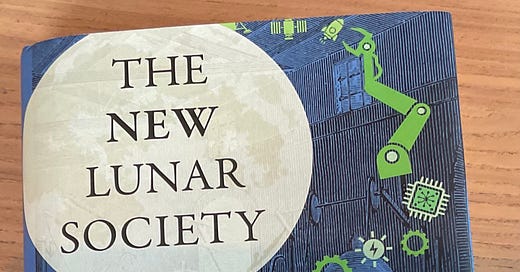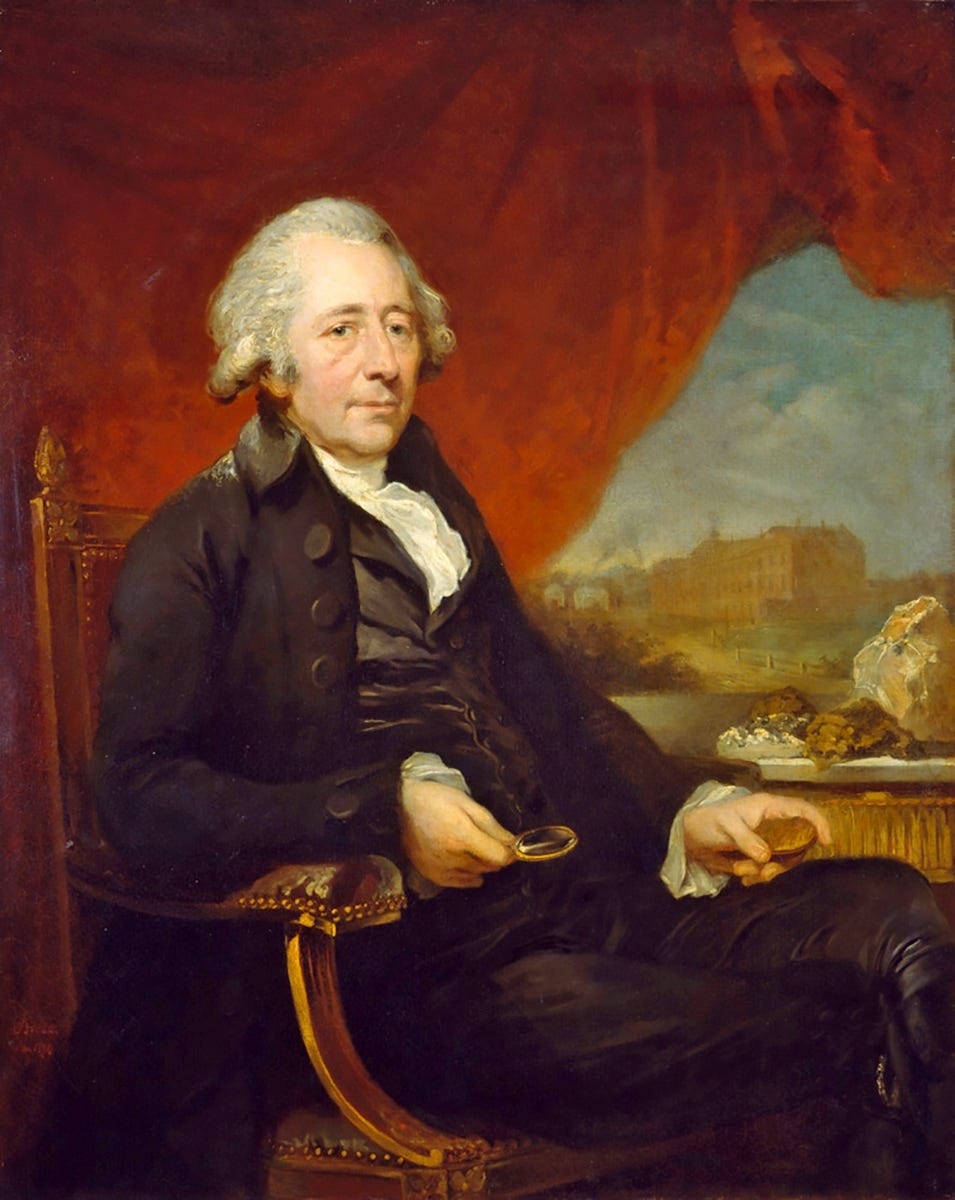9 June 2025. Industry | Transport
The next industrial revolution // Imagining scenarios for 2100 // Update: populism [#J2T 641]
Welcome to Just Two Things, which I try to publish a couple of times a week. Some links may also appear on my blog from time to time. Links to the main articles are in cross-heads as well as the story. A reminder that if you don’t see Just Two Things in your inbox, it might have been routed to your spam filter. Comments are open.
Apologies for the gap in posting: a big work commitment was followed by a week’s holiday.
1: The next industrial revolution
David Mindell is an eminent American academic and entrepreneur, and in The New Lunar Society he draws on the group of (mostly) men who forged the industrial revolution in 18th century Britain to try to write about the next industrial revolution in the 21st.
(Photo: Andrew Curry. CC BY-NC-SA 4.0)
The Lunar Society, celebrated in Jenny Uglow’s fine book about them, included most of the leading industrialists in Britain at the time. They met on the full moon, because it was safer to get home when it was lighter.
The relationship between Matthew Boulton and James Watt is at the heart of the narrative, and you can see why. Watt gets most of the credit for the invention that transformed Trescothick’s engine, but he probably deserves less of it. Because Watt’s improvements were product innovation, but Boulton turned this into process innovation. Boulton created a production system to scale up Watt’s invention.
Mindell argues that the US has focussed too much on product innovation (‘designed by Apple in California’) and not enough on process innovation. In practice, you need them both.
Economists get the blame for this—or specifically, an economist, in the person of Adam Smith, because his model of the division of labour and the pin-making factory seems largely to have been made up from his reading of Diderot’s Encyclopédie.
Mindell points out that there were actual factories within reach of Smith, but he seems never to have felt the need to visit them to see show they worked in practice. This led to errors: pin factories that adopted the division of labour were more productive, but by a factor of two, not the factor of 240 that he claimed. And larger factories were not more productive than small ones.
This sounds like the arcana of economic history, but it matters because it illustrates a larger point that remains relevant today:
Smith’s distortion matches surprisingly well how today’s economists missed the social, political, and technological importance of manufacturing in favor of all-out globalization... Thanks to the misreadings of Smith’s descendants, economic policy in the United States enabled the decline of manufacturing, confident that the new information and service sectors would replace those jobs. [33, 34]
Multiplier effects
This matters because manufacturing has disproportionate multiplier effects—close to a factor of four, in both income and jobs, on the rest of the economy. Manufacturing also connects product innovation to process innovation: the benefits of designers working near manufacturers to solve problems create technical solutions that can often spread beyond the specific factory to the wider production ecosphere. Mindell quotes Bonvillian on China: that “produce there/innovate there” may have been more disruptive than Apple’s model of “innovate here/ produce there.”
I’m not sure that there is a definition of process innovation in the book, and this might be because the literature isn’t that definitive. But by deduction from the text, I’d say it has three main characteristics:
an ecology of manufacturing, in which innovations in one sector spill over into others;
a close and continuing relationship between design and production; and
a focus on the end to-end production system.
This also reminded me of Peter Drucker’s distinction between invention and innovation. An innovator concerns themselves with all of the things needed to get an invention into use.
(Portrait of Matthew Boulton by Carl Frederik von Breda. Public domain.)
Given this, it’s not surprising that Mindel is a big fan of Matthew Boulton. Watt had the insight, that by adding a condensing valve you could make the steam engine more efficient and smaller, while generating more power more consistently.
But it needed Boulton to amass the different forms of expertise to develop it first as a product and then as a category. He waited for the right time to buy the rights from Watt’s first investor to ensure he could sell at scale; he built a factory on the canal to enable delivery of raw materials and distribution of the products.
He had assembled (from Birmingham’s ‘toy’ industry, which made watches and gadgets, a workforce that could build large machines reliably to small tolerances. He and Watt developed a language that made plans precise enough for the workers to craft the machines. Boulton was also charming with customers and investors alike, as they started on the long haul of selling the product, whereas Watt was curmudgeonly.
Mindell also writes about Josiah Wedgwood admiringly, and with good reason. Wedgwood more or less created the British porcelain industry. He was a chemist, and his ‘creamware’ pottery—both affordable and of good quality—was the product of hundreds of carefully documented experiments. But he also seems curiously modern in his interest in his customers (women buying for the domestic sphere), the marketing potential of associating his products with royalty (Catherine the Great bought thousands of pieces), the way he stratified the market by price, design, and quality, in his relentless innovation, and in using china as a form of media.
(‘Am I not a man?’. Image: Victoria and Albert Museum)
As part of the campaign against slavery, for example,
he contributed in the way he knew how: by making ceramics. In 1787, he created a medallion in jasper that depicted an enslaved man, in chains, on his knees, looking upward, with the words "Am I not a man and a brother?" [xx]
He gave away thousands of these, sending them by the boxful to other abolitionist campaigners, and they became a symbol of the anti-slavery movement.
Wedgwood also has the best quote in the book. His goal, he said, was
“to astonish the world all at once, for I hate piddling, you know.”
Connectors
But the connectors in the Lunar Society were also important. Many of these entrepreneurs were religious dissenters, and therefore excluded from British universities. Many of them met through the ‘dissenters’ academies’. The leading one was in Warrington, where Joseph Priestley modernised the curriculum to teach through practice. William Small, who had taught Thomas Jefferson while in the United States, introduced Boulton to Watt and acted as a kind of informal secretary for the Lunar Society. There are others as well.
There are obvious lessons for Mindell to take from all of this for his dream of a modern industrial system. One is the experimentation that led to process innovation. Another is the concern for the whole industrial system, from end-to-end. Wedgwood campaigned for better roads and celebrated the coming of the canal by building a factory alongside it.
A third is the interest in areas of research and production outside of your own. Mindell also touches on the exclusion of dissenters from many forms of public life, which pushed them into manufacturing, although some of the obvious conclusions from this, which he doesn’t develop, are uncomfortable to modern sensibilities.
Along the way, more or less woven through the text, he makes some notes on the nature of industry in modern society that are worth pulling together here.
It can take decades to transform a system, even when a technology “has been invented, deployed, and proven.” Some of this is down to safety and reliability issues. Mindell’s rule of thumb here is 30 years. Which means that the technologies we need to decarbonise already need to be working, somewhere. [161ff]
That industrial systems are really about material flows. He describes such systems as “large scale technological networks that provide for basic material human needs.” These are large and capital intensive. They also need stability, not disruption—precisely because they are supplying basic human needs. [47ff]
The continuing importance of repair and maintenance. Mindell draws on the work of the historian David Edgerton here, who writes in his terrific book The Shock of the Old that “maintenance and repair are the most widespread forms of technological expertise”, but are constantly overlooked. Similarly, Lee Vinsel and Andrew Russel argue that “maintenance mindset is crucial to any move towards technological sustainability.” [127ff]
There’s a ‘cult of the new’ around technologies that is harmful to innovation. This leads, he says, to a picture of technology that “is shallow, utopian, market-driven.” When technologies fail to be adopted, technological visionaries blame the rest of us. But adoption, Mindell suggests, ought to be challenging: “it is actually quite normal to reject most new technologies.” [135ff]
Silicon Valley doesn’t really understand innovation. If there’s an undertone in this book, it’s Mindell’s impatience with Californian technology ideologists. One of the findings of his MIT ‘Work of the Future’ project was that we would need more robots not less. His co-chair, David Autor, “pointed out that the demographics and other factors pointed to a shortage of workers for years to come.” [76]
Technologies always come with a politics attached to them—even when those politics are about not “interfering” with the market. But decarbonising our economies will require also reindustrialising them—and that is a political decision too. [77, 141]
The last few chapters have a kind of manifesto embedded in them, which needs a broader discussion in another post, since it reads as both pragmatically mundane and wildly utopian all at once.
The New Lunar Society is a short book, and it is written in short chapters. It takes a while to tune into the rhythm of his cross-cutting between now and the 1700s, which made for a choppy start to the book, at least for this reader.
Some of his writing about the present, especially early on, has the style of a thinktank report,1 perhaps because he co-chaired the ‘Work of the Future’ project. It is worth persisting past these pages. But if you’re more interested in The Lunar Society, I’d recommend Jenny Uglow’s fabulous group biography instead.
2: Imagining scenarios for 2100
Imagining long-term futures is hard, but it is more necessary than ever, as we wrestle with decisions about how best to adapt to the long-term effects of climate change. It is hard because significant change tends to happen on generational timescales, and long term futures can easily unfold over multiple generations. At the same time, decisions we need to take need to be taken now.
This was the challenge of a piece of work that SOIF did for the National Infrastructure Commission of Wales [NICW]. It has a remit to consider infrastructure decisions over 5-80 years. The NICW chair, David Clubb, tends to start presentations with a picture of a baby born in 2105, and a reminder that this is who they are building infrastructure for.
The brief was to build a set of scenarios that looked out to 2100–just because it is a round number—and then develop implications for decisions that would be taken between now and 2045.
There are creative ways to imagine long-term scenarios, but when designing futures processes that are to be used to inform policy it is better to be a little more formal. In this case, we built the 2100 scenarios in two stages, starting with a set of 2050s scenarios adapted from a set by the UK Government Office for Science, and then gave workshop groups a set of prompts to help them imagine how these might evolve over the following 40 years.
(What if? card #6. Source: Andrew Curry/SOIF.)
Any set of scenarios should fulfil a set of core criteria. Each individual scenario needs to be coherent; as a set they need to be distinctively different. And they also need to raise worthwhile strategic questions.
Long-term scenarios need to do a bit more. As we write in the report,
75 years is a long enough period of time for the world to change in ways that are unanticipated. For this reason, scenarios that take a longer term view should have within them elements that are genuinely discomfiting.
The four 2100 scenarios each take an aspect of a possible future and stretch it.
In ‘This Land Is Your Land’ forms of radical democracy and far greater subsidiarity prioritise the impact of decisions on wellbeing and the environment. In ‘Living in a Materials World’, a new ‘long wave’ of technology based on strong, cheap, lightweight materials has transformed the material environment. In ‘Creatures of Love’, large scale inward migration has brought new skills, climate change has brought new belief systems. The land, and other species are treated with reverence. And in ‘High Water Blues’, the costs of dealing with repeated extreme weather shocks have led to a long economic decline. Food and energy security are highly valued.
The second workshop tested these scenarios against a set of existing places, drawn from Understanding Welsh Places, representing a cross-section of Welsh towns. From this, participants were invited first to explore what a particular place might look like in each of the four scenarios, and then to think about what needed to happen in the next two decades to mitigate adverse outcomes or amplify good ones.
Among the implications from the scenarios, for transport planning and policy:
Assumptions about transport growth and our ability to maintain infrastructure may no longer hold;
Climate change will make transport more inconvenient and more difficult;
Digital infrastructure is likely to become less reliable;
We will need to think about infrastructure in a different way, making it more repairable and even ‘demountable’ and rebuildable;2
Communities will need more capability and capacity to cope with climate shocks. This will certainly include new skills, some involving maintenance and repair;
We’ll want communities to be more involved in their use of infrastructure. That might also involve different governance arrangements.
Of course, the point of doing this is two-fold. The first is to imagine different futures in such a way that we don’t lock ourselves into behaviours that might not work in a future world (such as dependence on a continuously functioning internet to get access to transport.)
The second is to identify interventions in the short-to-medium term that might improve long-term outcomes. In some of the Welsh places, local greenways represented a form of strategic infrastructure in the medium-to-long term future, but were at risk of landslides because of a lack of maintenance. Investment now that helped to make such greenways more robust against adverse weather represents such an intervention.
The project report is due to be published by NICW in due course, and I am planning to write a guide to using the 2100 scenarios and the place-based methodology used in the second workshop to imagine local futures and worthwhile responses in other places.
A shorter version of this post first appeared on the SOIF blog.
UPDATE: Politics and populism
Regular readers will know that I have written here repeatedly about the idiocy of centrist and centre-left parties trying to head off the threat from far-right and hard-right parties by aping their policies. It is based on bad analysis, it is bad politics, and it leads to bad policy.3
Recent analysis in The Conversation of switchers in voting intention since last year’s British General Election also suggests that it doesn’t work at an electoral level either. For non-UK readers, Reform is a hard-right party that emerged out of the pro-Brexit UK Independence Party (UKIP), and it performed strongly in recent local elections in the UK, as well as winning a seat in a Parliamentary by-election.
Here’s a couple of telling extracts from that article, by Paul Whiteley of the University of Essex:
The survey compares respondent voting intention to their votes in the 2024 general election... Alarmingly for Labour, only 60% of their 2024 voters have remained loyal and 15% intend to vote for Reform, while 12% switched to the Liberal Democrats and 9% to the Greens. Labour has been squeezed from both sides of the political spectrum, but the loss to the left is significantly larger than the loss to the right. (My emphasis.)
And adopting ‘Reform-lite’ politics has had absolutely no effect. (Why would someone vote for Labour because they wanted hardline immigration policies when they could get harder line immigration policies, with accompanying rhetoric, from Reform?):
Not surprisingly, 91% of Reform voters have remained loyal, with 5% going to the Conservatives and 3% going to the Greens. None of the Reform voters have switched to Labour or the Liberal Democrats. (My emphasis).
There’s also data on the striking age profiles of British voters, perhaps currently the single biggest indicator of likely voting intention:
[O]nly 8% of 18 to 24-year-olds support Reform, compared with 35% of 50 to 64-year-olds and 33% of the over-65s. Some 34% of the younger group support Labour, 12% the Conservatives, 15% the Liberal Democrats and 25% the Greens.
We’re getting to a point where progressive political parties need to have a strategy that cements the support of younger voters while trying to broaden their coalition. Things like a credible rent reform plan might be a good place to start—along with dealing with the vast education debts incurred since university fees were increased sharply 15 years ago.
j2t#641
If you are enjoying Just Two Things, please do send it on to a friend or colleague.
“AI: rewrite these scrappy notes in the all-knowing style of a McKinsey Global Institute report.”
Cindy Frewen had a good essay about this in the APF’s 10th anniversary book The Future of Futures, which I edited.
In the case of the UK, for example, it gives the Home Office an effective veto over policies that would help the government’s so-called ‘growth’ agenda, and undermines institutions such as the UK’s university sector, where the UK is actually internationally competitive.






